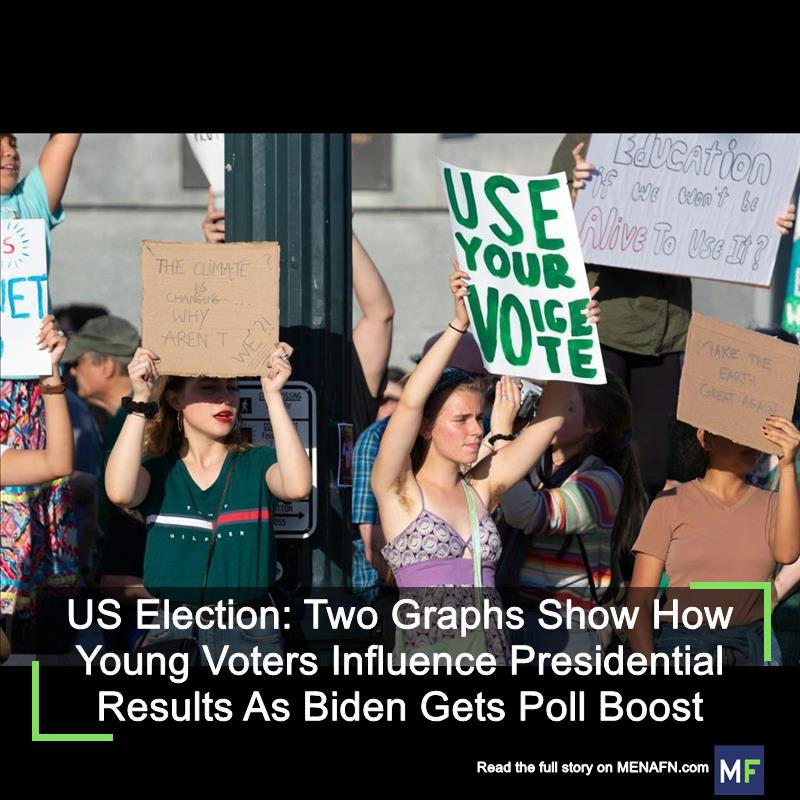
US Election: Two Graphs Show How Young Voters Influence Presidential Results As Biden Gets Poll Boost
One source of polarisation that is rarely discussed is the divide between young and old voters at elections. Over the past 50 years, young and old have often supported the same candidate, but in 2024 younger voters are expected to be particularly important .
In 1971, the 26th amendment of the US constitution changed the minimum voting age from 21 to 18, bringing swathes of new voters to the ballot box.
The 1972 contest was a challenge for both parties, who wanted to make sure to win over these new younger voters. Republican Richard Nixon was up against Democrat challenger George McGovern. While college-educated young voters appeared to like McGovern because he opposed the Vietnam war (which was the focus of enormous protests on university campuses ), non-college goers seemed to swing towards Nixon. Older voters were also showing their preferences for Nixon.
Although McGovern was the favourite to win the young vote, Nixon was determined not to ignore younger voters in his campaign . He even appointed a full-time member of staff to create campaigning specifically for these new voters, running a new organisation Young Voters for the President. Nixon unexpectedly won almost half the first-time voters .
However, in the 1970s and early 1980s there was little difference between the two age groups in their support for the Democrats. The chart below compares the voting behaviour of young and old Democratic voters in every presidential election since 1972.
It shows support for Democratic candidates in these elections by different age groups. Young voters are defined as those under the age of 25 and old voters those over the age of 64. The data comes from the American National Election Study (ANES).
The relationship between voting for the Democrats and age in US presidential elections from 1972 to 2020:
ANES, Author provided (no reuse)
This pattern of voting started to change after the landslide victory for Republican George Bush senior in 1988.
When Bush was defeated by Democrat Bill Clinton in 1992, Clinton gained support from both young and old Americans by significant margins. That across-the-board support began to shift during his term of office though.
Biden did well among young voters in the 2020 election. Andrew Cline/Alamy
The young became more enthusiastic supporters of the Democrats compared with older voters, and since then the divergence in support has continued to widen. In 2020, 74% of the young voted for Democrat Joe Biden, compared with 55% of the older group. Biden won 60% of voters ages 18-29, compared to Donald Trump's 36% in 2020.
What explains this trend, and why are the votes of those different age groups now so different? There are two broad factors at work: the first relates to the ideological leanings of young Americans compared with their older counterparts. The chart below shows responses to a question in the 2020 ANES survey asking respondents where they place themselves on a left-right ideological scale.
The ideological attachments of young and old voters in the US presidential election of 2020:
ANES, Author provided (no reuse)
The chart above shows that young voters are much more likely to consider themselves as liberals compared to their older counterparts. Altogether, 49% of young Americans described themselves as liberals, with 29% describing themselves as conservatives. This is in sharp contrast to older voters with 29% liberals, and 47% conservatives.
This trend was confirmed by additional questions asking about contentious issues dividing liberals from conservatives. Some 57% of young voters were completely pro-choice on abortion, compared with 41% of older voters . Equally 32% of young Americans were very strongly in favour of affirmative action or government assistance for Black and ethnic minority people, compared with only 13% of voters over 60.
Read more: US election: turning off TikTok is a big risk for the Democrats
The second factor is the economic performance of the incumbent president, which has a strong influence on voting behaviour. In 2020, 17% of young voters (18-29) said the economy had got better and 56.7% said it had become worse in the last year .
The equivalent figures for older voters (over 60) were 21.4% said it had got better and 57.7% said it had got worse. Clearly, in that year young people were less positive than the older generation.
Youthful boost for BidenIn 2024, Biden's campaign team are very focused on the youth vote, attempting to build on their success in gaining their support for the Democrats in the midterms. But there had been some suggestions, in late 2023, that this age group was slipping away .
However, an Economist/YouGov poll conducted on March 10-12 2024 reported some encouraging news for the Democrats. It found 55% of voters between 18 and 29 had a favourable opinion of Biden, compared with 38% of respondents over over the age of 65. In contrast 40% of the young had a favourable opinion of Trump, compared with 50% of older voters.
This may partly be down to the efforts of the Democrats to woo and work with social media influencers as well as building a significant TikTok presence . The Biden team will want to build on this during the campaign, as it could create the margin that will deliver a win for them in November.

Legal Disclaimer:
MENAFN provides the
information “as is” without warranty of any kind. We do not accept
any responsibility or liability for the accuracy, content, images,
videos, licenses, completeness, legality, or reliability of the information
contained in this article. If you have any complaints or copyright
issues related to this article, kindly contact the provider above.


















Comments
No comment